LIFE CYCLES OF DIFFERENT ANIMALS
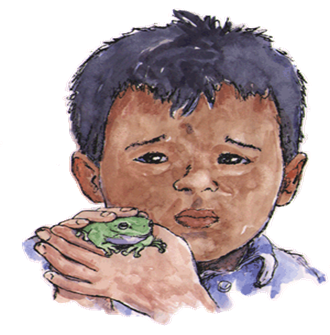
All
animals reproduce more of their own kind, and their offspring grow, change, and
eventually reproduce. Most animals come from
eggs produced by the female and fertilized by the male. Fertilized eggs contain everything needed to
form a new animal. When the animal has
grown enough, it breaks out of the egg.
This is called hatching.
Many
young animals look much like their parents, while others do not. Some go through stages of growth. In each stage of growth they look more like
their parents.
Take a look at the life cycle of a
frog to see how it grows from an egg to an adult.
|
Step
1 |
Step
2 |
Step
3 |
Step
4 |
|
|
|
|
|
1. A frog lays its eggs in water.
2. The eggs hatch into a tadpole. Each tadpole has a rounded body, a long tail,
fins, and gills that are used for breathing in water.
3. A tadpole grows quickly. After five weeks, the tadpole’s back legs
develop, followed shortly by development of the front legs. During this time, the tadpole’s tail begins
to shorten. The tadpole also begins to
develop lungs to replace its gills. As
weeks pass the young tadpole becomes more like the adult.
4. The adult frog makes its way out of the water onto land. It has lost its tail and can use its legs and
lungs.
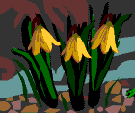
Let’s
look next at how a butterfly changes from an egg to an adult.
|
Step
1 |
Step
2 |
Step
3 |
Step
4 |
|
|
|
|
|
1. The butterfly lays its eggs on a
leaf.
2. When the egg hatches, a larva
emerges. A butterfly larva is called a
caterpillar. A larva is always hungry and eats constantly. After a certain time, the larva stops eating.
3. It then makes a covering for itself,
which is usually semi-hard. It attaches
itself to a tree branch, and is now called a pupa. The pupa is the stage of the insect between a
larva and an adult. During the pupa stage, the butterfly begins to
develop. Inside the covering the pupa
slowly changes.
4. When the changes are complete, the
adult butterfly emerges. Now the insect
looks the same as other adults of its kind.
ACTIVITY I
RAISE A MONARCH BUTTERFLY
1. How
to make a home for your Monarch caterpillar:
Find
a big, clean glass jar with a metal lid.
Make several holes in the lid with a hammer and nail so air can get
inside the jar.
2. How
to find your Monarch caterpillar:
Late
July and August is the best time to find a Monarch caterpillar. Go to a field where milkweed plants
grow. Look underneath the milkweed
leaves. When you find a Monarch caterpillar, pick it up gently.
3. How
to care for your Monarch caterpillar:
Pick four or five
leaves from the milkweed plant and drop them into the jar for the caterpillar
to eat. Then, carefully put the
caterpillar into the jar and put the lid on.
Don’t set the jar in a sunny place.
Each day have someone watch the caterpillar while you clean its
home. Replace the old milkweed leaves
with new ones. Then put the caterpillar
back inside the jar.
4. Your
caterpillar will change into a chrysalis:
When the caterpillar is full grown, it will hang upside down
from the lid of the jar, shed its skin, and form its chrysalis. Don’t touch the chrysalis.
5. The
chrysalis will change into your Monarch butterfly:
In about two weeks, you will be able to see through the
chrysalis. When this occurs it is time
for the Monarch butterfly to emerge.
When it does emerge, it will need a few hours for its wings to grow and
dry.
6. How
to release your butterfly outside:
A
Monarch butterfly doesn’t want to be a pet.
Carefully let it climb out of the jar onto your finger. When it is ready to go, it will fly up into
the sky. Or you can the leave opened jar
outside in a safe place.
Click on the link below to learn more
about the Monarch Butterfly.
https://www.monarch-butterfly.com/
ACTIVITY II
WATCH BUTTERFLIES AND MOTHS

You
can photograph butterflies and moths or catch them in a net for better
examination. When watching butterflies or
moths, you can discover the answers to many questions about their
behavior. Do they feed at a certain time
of day? Do they have a territory, and if
so, how do they defend it? Do they
migrate, and if so, when and to where?
Do their flight patterns change in different seasons? Studying butterflies is simple but takes
time. You do not need much equipment,
just patience.
Equipment:
1.
Notebook
– to draw pictures of them and record what you see
2.
Camera
3.
Telescope
4.
Butterfly
net
ACTIVITY III

Ask
your local greenhouse what plants attract butterflies. Then start a butterfly garden and enjoy
watching them in your yard.
ACTIVITY IV
COLLECT FROGS EGGS AND TADPOLES
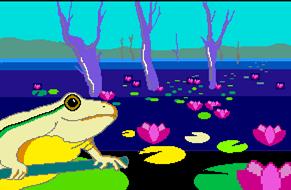
Equipment for Collecting
To
gather tadpoles or frog eggs, you’ll need a long-handled collecting net and a
container in which to carry your finds.
You can buy a collecting net, but it’s easy to make one.
What to Do:
Tape
a food strainer tightly to a mop handle.
If you’re using fabric, follow these steps:
2. Put your bag or fabric through the loop, so that
it forms a pouch about 12 inches (30 cm) deep.
If you are using a section of material cut from an old pair of tights,
sew the bottom of the pouch closed.
4. Tape
the net to the handle.
Your
container can be any sort of wide-mouthed plastic pail or jar, deep enough (or
with a lid) to keep water from splashing out when you carry it. Fill the container with pond water at the
collecting site. You may also find it
helpful to bring along a shallow, light-colored container, such as a dishpan or
an old food keeper. If you empty your
net into the flat pan first, it will be easy to see and sort out debris and
water creatures that you don’t want.
Then you can put only the material that you do want in your collecting
jar.
When and Where to
Search
Spring
is the best time to find eggs and tadpoles because that’s when frogs normally
lay their eggs. The eggs hatch quickly,
and the tadpoles of most species grow into frogs in just a few weeks. Later in the year, you may still find the
tadpoles of bullfrogs, which take two to four years to reach adulthood, and
green frogs, which will not become adults until the following year. These large tadpoles (with bodies the size of
a grape or bigger) are best left in the wild—they need a pond-sized habitat in
which to grow up.
Look
for eggs and tadpoles in shallow, quiet, fresh water—along the edges of ponds
and marshes, in shallow garden pools, even in ditches and other temporary wet
spots that dry up in summer. When you
visit a pond or a marsh, take an adult with you, and follow these steps for
safety:
· Wear old sneakers or sandals for
wading—don’t go barefoot because glass or sharp stones may be hidden under the
water.
· Use your net handle or another pole
to test the depth of the water ahead of you, to be sure that the bottom doesn’t
drop off suddenly.
· Avoid streams with fast-running
currents—they can be dangerous, and you won’t find eggs or tadpoles there.
· Don’t hunt for eggs and tadpoles from
a boat or wharf—you might fall in deep water.
Frog
eggs look like little black balls or seeds, encased in jelly. You’ll normally find them in masses that may
contain dozens, hundreds, even thousands of eggs. Don’t take all the eggs—scoop up a dozen or
so with your net, and put them in your collecting container.
 Hunt for tadpoles where water
plants grow. Tiny tadpoles are hard to
spot. But if you sweep your net through
a clump of water plants, you may catch some even without seeing them. Collect just a few tadpoles, and put some
pond plants in your container along with them.
Hunt for tadpoles where water
plants grow. Tiny tadpoles are hard to
spot. But if you sweep your net through
a clump of water plants, you may catch some even without seeing them. Collect just a few tadpoles, and put some
pond plants in your container along with them.
To
make sure that your tadpoles and frog eggs arrive home safely, follow these
steps:
· Make sure that other pond animals
don’t end up in the container with the tadpoles of the eggs. Small fish and other water creatures may eat
them. Some large tadpoles will eat small
tadpoles, too—so gather tadpoles that are all about the same size.
· Use a large collection container with
plenty of pond water.
· Don’t let the container sit in direct
sunlight, which can heat the water and harm the tadpoles.
· Cover the container only to carry
it. Otherwise, leave the cover off, so
that air can reach the water surface.
ACTIVITY V
CARING FOR EGGS
AND TADPOLES
You’ll
need to set up a more permanent container to keep eggs or tadpoles for a period
of time. If you collect both eggs and
tadpoles, put them in separate containers.
Use a small aquarium, a large glass jar, or a plastic food-storage
container, leaving the container uncovered.
Fill
the container with pond water or spring water.
Most tap water contains chlorine, which will harm tadpoles. The water will be safe to use only if you
treat it with chlorine remover (available in pet stores) or let it stand for 24
hours before adding it to the container, so that the chlorine disappears. The water should be at room temperature. Keep the container out of direct sunlight and
away from heat sources, such as radiators.
"Frogs
Need Friends"
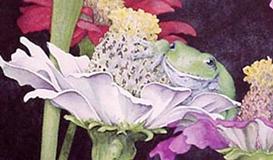
 Add
some pond plants to your tadpole container (and to your egg container when the
eggs begin to hatch, which in most cases will be within a week or two). Don’t crowd the tadpoles—you’ll be able to
keep five or six in a 1-gallon container.
If you’ve collected eggs, keep just a few of the tadpoles that
hatch. Return the rest to the pond where
you found the eggs.
Add
some pond plants to your tadpole container (and to your egg container when the
eggs begin to hatch, which in most cases will be within a week or two). Don’t crowd the tadpoles—you’ll be able to
keep five or six in a 1-gallon container.
If you’ve collected eggs, keep just a few of the tadpoles that
hatch. Return the rest to the pond where
you found the eggs.
Feed
them lettuce and spinach leaves. Tear
the leaves into 1-inch pieces and ask an adult to boil them for one
minute. You can also boil a pinch of
cornmeal with the lettuce and spinach pieces.
Once they develop legs, feed them a small piece of liver or a bit of
hard-cooked egg yolk, along with cooked cornmeal. Remove food that is not eaten.
Change
the water every day. (Always use
chlorine free water.) Remove waste from
the bottom of the tank with a meat baster.
Use a strainer or aquarium net to transfer tadpoles to other
containers. Add a rock so that they can
climb on it when they grow four legs.
When
they have four legs and nearly lose their tails, release them on land.
ACTIVITY VI

Keep a tadpole notebook, including dates, notes, and drawings. Every few days, observe the tadpoles and record the changes they are going through. Note new features, such as legs, when they begin to appear, and make drawings of tadpoles as they change. Record changes in their behavior. For example, note when they begin to breathe air at the surface.
Suggested
Reading:
Amazing World of Butterflies and Moths
by Louis Sabin (Troll Associates)
Butterfly and Moth by Paul Whalley and
Ernest Sutton Whalley (Eyewitness
Books)
From Tadpole to Frog by Wendy Pfeffer (Harper Collins)
Monarch Butterfly by Gail Gibbon (Holiday House)
Tadpoles by Elaine Pascoe (Blackbirch
Press)
The Butterfly by Angela Sheehan (Warwick
Press)
The Tadpole by Hidetomo Oda (Raintree)
The World of Butterflies by David Saintsing (Gareth Stevens)

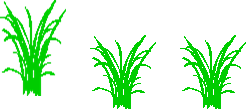
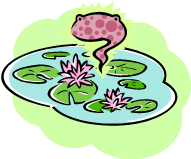
The 1982 book "The Caterpillar
and the Polliwog" by Jack Kent comes alive in this animated
program. Two new friends discover, on their own, that spring is the time to
turn into "something else." Part of the Weston Woods Series. The
video is divided into three short segments.

Below are additional educational resources and activities for this unit.






